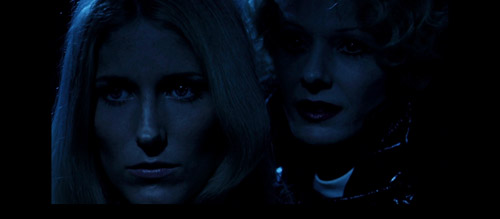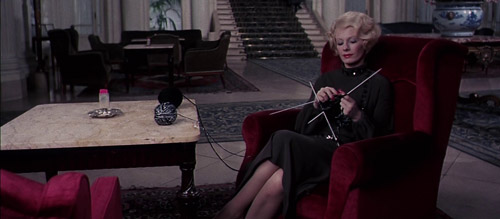Daughters of Darkness (1971) Review
This article was written exclusively for The Film Magazine by Eve O’Dea of eveonfilm.com.
Daughters of Darkness (1971)
Director: Harry Kümel
Screenwriter: Harry Kümel
Cast: Delphine Seyrig, John Karlen, Daniella Ouimet, Andrea Rau
Harry Kümel’s Daughters of Darkness exists in a liminal space, hovering between several realms of definition. This pervasive uncertainty contributes to the feeling of unease and anxiety that makes a film effectively creepy and eerie, cementing it in the horror genre. However, as certain facets are left up in the air in an attempt to create a disjointed atmosphere, we are left with a film that is unsure of itself and appears unfinished, like a half-painted canvas or play without a third act.
Daughters of Darkness follows a newlywed couple, Valerie and Stefan, as they reside in a Belgian seaside hotel over several nights. While at the hotel, the couple meets the elusive Hungarian countess Elizabeth Bathóry and her quiet secretary, Ilona. As tensions rise between the foursome, unnatural forces soon come to the surface, with fatal consequences.
Though directed by a Belgian man and taking place in the Belgian seaside town of Ostend, the film could hardly be pinned down by any particular country. “A Belgian-French-German co-production” appears during the opening credits. The film’s pan-European atmosphere is represented in the main cast: Valerie, whose exact nationality is unknown, is played by French-Canadian actress Daniella Ouimet; Stefan, a Brit raised in America, is played by American actor John Karlen; Elizabeth, a Hungarian, is played by legendary French actress Delphine Seyrig; while Andrea Rau, a German, plays the nationally ambiguous Ilona. As a result of the characters’ multi-nationality, they speak English to one another with varying levels of proficiency. Andrea Rau truly does not seem to understand what she is saying, resulting in a character that remains undefined and distant; Danielle Ouimet is only slightly more capable in her performance, though her character is overly disoriented, lacking any clear intention; John Karlen does well as a detestable jerk with violent tendencies, though several of his character motivations remain unclear by the end of the film. While shared commonality of English contributes to the element of mystique and tension between characters, it also leads to dialogue that is overly cryptic and void of real meaning.
As three of the four actors are somewhat forgettable, the film relies on not only the capability of Delphine Seyrig, but also her unbelievable magnetism. Despite the film’s flaws, Seyrig’s performance elevates it to a piece worth remembering. More than any of the other actors, she understands her role and her dialogue as if the words came from her own mind. Her presence is so captivating that any scene without her feels lacking, and the audience craves her return.
Despite the somewhat lacking abilities of the wider cast, the film is undoubtedly stylish. Every scene is dominated by bright, rich colour, much like the striking work of Dario Argento. Scenes fade to red rather than to black, a fantastic detail that emphasizes the importance of colour. The contrast between the lightness of the scenery and the darkness of the gothic story further contribute to the film’s displacement and feeling of uneasiness. In this case, such an ‘in between-ness’ is an effective method that makes the film horrific and memorable. The costumes, particularly that of the women, are over-the-top and dramatic representations of the decade’s extravagance: fur-lined leather coats, purple feathers, silver sequin floor length gowns, etc., all indicate the film’s priority of style over substance. Seyrig in particular is adorned in such wonderful gowns that on another actress may appear overpowering, but on her appear perfectly natural, as if she sleeps in such apparel.
Seyrig’s persona is a major reason why the film feels as if floating amid definition. The film takes place in the early 1970s which informs the extravagant disco-esque fashion, but Seyrig’s wardrobe is also greatly inspired by the glamour of the 1930s, featuring bright red lips, bleach-blonde finger waves and plucked eyebrows. Then there is the fact that her character, Countess Elizabeth Bathóry, is several centuries old. Much like the Belgian town of Bruges, a city that has been preserved as a monument to medieval architecture, Seyrig eludes definition of any particular time period, and adds to the feeling of instability that pervades through the film. Seyrig’s fashion is also essential to her character’s queerness. Though she wears typically feminine clothing, she dresses so pristinely and impractically that she appears to be playing a woman rather than actually being one of flesh and blood. In a sense, Seyrig transcends the gender binary, further contributing to her enigmatic screen presence and the film’s liminality.
Daughters of Darkness is accompanied by a new-wave, synth-dominated score which is used frequently to enhance dramatic moments. Such theatrical elements legitimize the film’s status as a camp-classic. Much of the film’s charm is rooted in its excessiveness, from its acting, to its costumes, to its intrusive editing, to its gauzy cinematography taken straight from 1930s glamour shots. The film is simply unable to resist indulgence. Though technically amateurish, should these elements be removed, the film would be rather lifeless and lose its essence. Paradoxically, the parts of the film that drag it down critically are essential to its very being.
Tied in to the film’s striking visuals and campy ambience is the film’s representation of queer characters. Here, we are presented with another instance of the film’s ambivalence. While progressive in that any representation of queer characters in the the early 1970s was rare, the film contributes to the ongoing trend of associating queerness with premature death and violence.
The association between vampires and queerness was hardly established by Daughters of Darkness. The modern vampire as created by Bram Stoker is allegorical to sexual perversion, sneaking into one’s bedroom in the middle of the night, positioning the mouth on the neck, desiring eternal youth and beauty. Even before the publication of “Dracula” in 1897, Sheridan Le Fanu wrote “Carmilla”, a story of a female vampire who lusts after a virginal young woman. The threat of homosexuality is amplified by a threat of death, and the two become synonymous. As is typical of twentieth century vampire stories, the vampire must die so the good may go on living, as must the queer die so the heteronormative structure may flourish.
In Daughters of Darkness, the overtly queer Elizabeth Bathóry, who is based on a historical seventeenth century serial killer, and her companion Ilona, murder young women for their blood, but also out of queer desire. Again, we are presented with the equation of queerness to violence and corruption. By the end of the film, after several days of pursuing Valerie and finally succeeding in turning her into a vampire and her lover, Elizabeth dies preposterously and without dignity. Though it seems like she and Valerie might get away to live happily together, such optimism is quickly pulled out from underneath them. A similar plot is depicted in The Hunger (1983), starring Catherine Deneuve as the immortal pansexual being and Susan Sarandon as her vulnerable prey. As would be expected of a queer character in 1983, Deneuve dies rather unreasonably. Though released just before the AIDS crisis became prevalent in the American conscious, The Hunger presents an interesting commentary on how such a disease prematurely ripped apart queer partnerships. Daughters of Darkness is devoid of any such prophetic imagery, rather treating the queer as a disposable monster akin to those of Universal Studios in the 1930s.
For various reasons, Daughters of Darkness feels incomplete and devoid of clear motivation. The glamour helps disguise this hollowness, but only to a certain extent. The elements that make it cryptic and mysterious also leave it cold and unfulfilled, but in a way, it is this elusiveness that is crucial to the film’s identity.
15/24
Written by Eve O’Dea
You can support Eve O’Dea in the following places:
Website – eveonfilm.com
Twitter – @EveOnFilm



